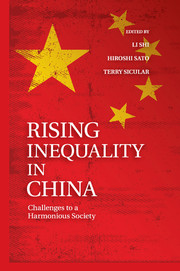Book contents
- Frontmatter
- Contents
- List of Tables
- List of Figures
- Contributors
- Preface
- Abbreviations
- Glossary
- 1 Rising Inequality in China
- 2 Overview
- 3 Housing Ownership, Incomes, and Inequality in China, 2002–2007
- 4 Educational Inequality in China
- 5 Inequality and Poverty in Rural China
- 6 The Evolution of the Migrant Labor Market in China, 2002–2007
- 7 A New Episode of Increased Urban Income Inequality in China
- 8 Unemployment and the Rising Number of Nonworkers in Urban China
- 9 Do Employees in the Public Sector Still Enjoy Earnings Advantages?
- 10 Redistributive Impacts of the Personal Income Tax in Urban China
- 11 Changes in the Gender-Wage Gap in Urban China, 1995–2007
- 12 Intertemporal Changes in Ethnic Urban Earnings Disparities in China
- Appendix I The 2007 Household Surveys
- Appendix II The 2002 and 2007 CHIP Surveys
- Index
- References
12 - Intertemporal Changes in Ethnic Urban Earnings Disparities in China
Published online by Cambridge University Press: 05 July 2013
- Frontmatter
- Contents
- List of Tables
- List of Figures
- Contributors
- Preface
- Abbreviations
- Glossary
- 1 Rising Inequality in China
- 2 Overview
- 3 Housing Ownership, Incomes, and Inequality in China, 2002–2007
- 4 Educational Inequality in China
- 5 Inequality and Poverty in Rural China
- 6 The Evolution of the Migrant Labor Market in China, 2002–2007
- 7 A New Episode of Increased Urban Income Inequality in China
- 8 Unemployment and the Rising Number of Nonworkers in Urban China
- 9 Do Employees in the Public Sector Still Enjoy Earnings Advantages?
- 10 Redistributive Impacts of the Personal Income Tax in Urban China
- 11 Changes in the Gender-Wage Gap in Urban China, 1995–2007
- 12 Intertemporal Changes in Ethnic Urban Earnings Disparities in China
- Appendix I The 2007 Household Surveys
- Appendix II The 2002 and 2007 CHIP Surveys
- Index
- References
Summary
Introduction
The opening of the Chinese economy in 1978 by Deng Xiaoping ushered in an era of significant economic growth (Chow 1993). During the following thirty years, gross domestic production expanded, the manufacturing sector grew, and exports to the outside world skyrocketed. Much of this dramatic growth has been attributed to capital accumulation and productivity increases (Chow and Li 2002). Yet, the period also represented a significant shift in national policies toward growth tempered by attention to social equity (Friedman 2006). This shift under the Hu Jintao–Wen Jiabao leadership is commonly referred to as promotion of a “harmonious society.”
Figure 12.1 shows the significant advances of the Chinese economy over the thirty-year period. Annual average gross domestic product (GDP) growth during the period from 1978 to 2007 was 9.74 percent. By way of comparison, annual GDP growth in the United States during the same period was only 3.3 percent (Myers forthcoming).
One clear indicator of the slowing of the Chinese economy occurred during the 1992–1999 period. Figure 12.1 shows a growth rate of almost 15 percent in 1992, followed by a sharp decline in the ensuing years and only a little more than 7 percent in 1999.
- Type
- Chapter
- Information
- Rising Inequality in ChinaChallenges to a Harmonious Society, pp. 414 - 444Publisher: Cambridge University PressPrint publication year: 2013
References
- 2
- Cited by

